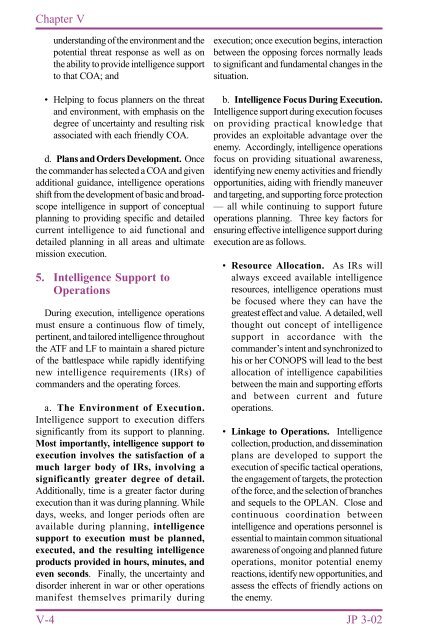Joint Doctrine for Amphibious Operations - Historic Naval Ships ...
Joint Doctrine for Amphibious Operations - Historic Naval Ships ...
Joint Doctrine for Amphibious Operations - Historic Naval Ships ...
- No tags were found...
Create successful ePaper yourself
Turn your PDF publications into a flip-book with our unique Google optimized e-Paper software.
Chapter VV-4understanding of the environment and thepotential threat response as well as onthe ability to provide intelligence supportto that COA; and• Helping to focus planners on the threatand environment, with emphasis on thedegree of uncertainty and resulting riskassociated with each friendly COA.d. Plans and Orders Development. Oncethe commander has selected a COA and givenadditional guidance, intelligence operationsshift from the development of basic and broadscopeintelligence in support of conceptualplanning to providing specific and detailedcurrent intelligence to aid functional anddetailed planning in all areas and ultimatemission execution.5. Intelligence Support to<strong>Operations</strong>During execution, intelligence operationsmust ensure a continuous flow of timely,pertinent, and tailored intelligence throughoutthe ATF and LF to maintain a shared pictureof the battlespace while rapidly identifyingnew intelligence requirements (IRs) ofcommanders and the operating <strong>for</strong>ces.a. The Environment of Execution.Intelligence support to execution differssignificantly from its support to planning.Most importantly, intelligence support toexecution involves the satisfaction of amuch larger body of IRs, involving asignificantly greater degree of detail.Additionally, time is a greater factor duringexecution than it was during planning. Whiledays, weeks, and longer periods often areavailable during planning, intelligencesupport to execution must be planned,executed, and the resulting intelligenceproducts provided in hours, minutes, andeven seconds. Finally, the uncertainty anddisorder inherent in war or other operationsmanifest themselves primarily duringexecution; once execution begins, interactionbetween the opposing <strong>for</strong>ces normally leadsto significant and fundamental changes in thesituation.b. Intelligence Focus During Execution.Intelligence support during execution focuseson providing practical knowledge thatprovides an exploitable advantage over theenemy. Accordingly, intelligence operationsfocus on providing situational awareness,identifying new enemy activities and friendlyopportunities, aiding with friendly maneuverand targeting, and supporting <strong>for</strong>ce protection— all while continuing to support futureoperations planning. Three key factors <strong>for</strong>ensuring effective intelligence support duringexecution are as follows.• Resource Allocation. As IRs willalways exceed available intelligenceresources, intelligence operations mustbe focused where they can have thegreatest effect and value. A detailed, wellthought out concept of intelligencesupport in accordance with thecommander’s intent and synchronized tohis or her CONOPS will lead to the bestallocation of intelligence capabilitiesbetween the main and supporting ef<strong>for</strong>tsand between current and futureoperations.• Linkage to <strong>Operations</strong>. Intelligencecollection, production, and disseminationplans are developed to support theexecution of specific tactical operations,the engagement of targets, the protectionof the <strong>for</strong>ce, and the selection of branchesand sequels to the OPLAN. Close andcontinuous coordination betweenintelligence and operations personnel isessential to maintain common situationalawareness of ongoing and planned futureoperations, monitor potential enemyreactions, identify new opportunities, andassess the effects of friendly actions onthe enemy.JP 3-02
















